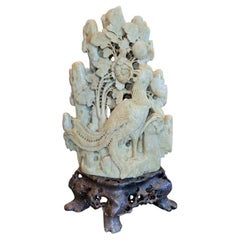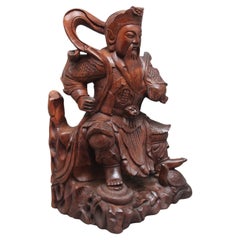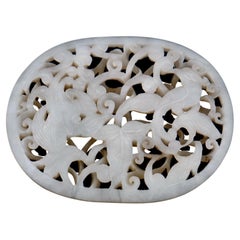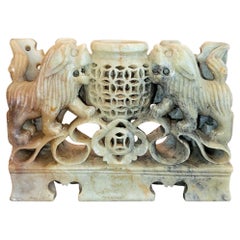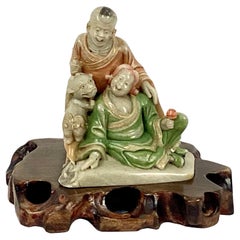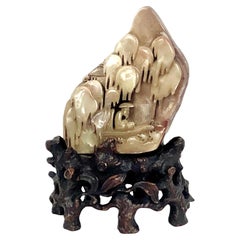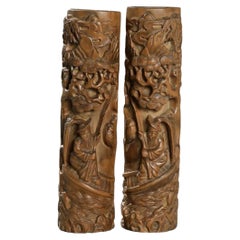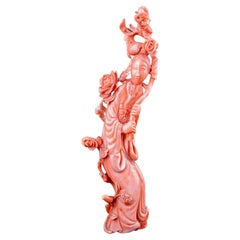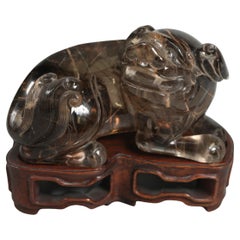Antique Chinese Carvings
Early 20th Century Chinese Chinese Export Antique Chinese Carvings
Soapstone
1880s Chinese Antique Chinese Carvings
Mahogany
19th Century Chinese Chinese Export Antique Chinese Carvings
Jade
Early 20th Century Chinese Chinese Export Antique Chinese Carvings
Soapstone
19th Century Chinese Qing Antique Chinese Carvings
Soapstone
19th Century Chinese Qing Antique Chinese Carvings
Soapstone
Early 20th Century Chinese Antique Chinese Carvings
Wood
Mid-19th Century Chinese Chinese Export Antique Chinese Carvings
Coral
Mid-19th Century Chinese Antique Chinese Carvings
Rock Crystal
Early 20th Century Chinese Antique Chinese Carvings
Jade
Early 1900s Chinese Victorian Antique Chinese Carvings
Wood
Early 20th Century Chinese Chinese Export Antique Chinese Carvings
Wood
Early 20th Century Chinese Chinese Export Antique Chinese Carvings
Stone
Early 18th Century Chinese Chinese Export Antique Chinese Carvings
Jade
1920s Chinese Qing Antique Chinese Carvings
Jade
Late 19th Century Chinese Qing Antique Chinese Carvings
Stone
Early 20th Century Chinese Folk Art Antique Chinese Carvings
Wood
1890s Chinese Antique Chinese Carvings
Jade
1880s Chinese Chinese Export Antique Chinese Carvings
Wood
19th Century Chinese Antique Chinese Carvings
Wood
19th Century Chinese Antique Chinese Carvings
Wood
Late 19th Century Antique Chinese Carvings
Jade
1880s Chinese Victorian Antique Chinese Carvings
Wood
Early 1900s Chinese Chinoiserie Antique Chinese Carvings
Wood
Late 19th Century Chinese Qing Antique Chinese Carvings
Cypress
19th Century Chinese Qing Antique Chinese Carvings
Giltwood
19th Century Chinese Qing Antique Chinese Carvings
Wood
19th Century Chinese Qing Antique Chinese Carvings
Wood
19th Century Chinese Qing Antique Chinese Carvings
Wood
Early 20th Century Chinese Chinese Export Antique Chinese Carvings
Soapstone
1920s Chinese Chinese Export Antique Chinese Carvings
Porcelain
Early 19th Century Chinese Other Antique Chinese Carvings
Coconut
Early 20th Century Chinese Chinese Export Antique Chinese Carvings
Jade
19th Century Chinese Qing Antique Chinese Carvings
Wood
19th Century Chinese Antique Chinese Carvings
Bronze
Early 20th Century Chinese Antique Chinese Carvings
Jade
Early 20th Century Chinese Antique Chinese Carvings
Jade
Early 20th Century Chinese Chinese Export Antique Chinese Carvings
Soapstone
Early 20th Century Chinese Antique Chinese Carvings
Jade
Early 20th Century Chinese Antique Chinese Carvings
Giltwood
Early 20th Century Chinese Antique Chinese Carvings
Soapstone
Early 20th Century Chinese Antique Chinese Carvings
Rock Crystal
Late 19th Century Chinese Chinese Export Antique Chinese Carvings
Jade
19th Century Chinese Qing Antique Chinese Carvings
Soapstone
Early 1800s Chinese Chinese Export Antique Chinese Carvings
Jade
Early 1600s Chinese Ming Antique Chinese Carvings
Bronze
Late 19th Century Chinese Qing Antique Chinese Carvings
Stoneware
Early 18th Century Chinese Qing Antique Chinese Carvings
Wood
Early 20th Century Chinese Antique Chinese Carvings
Early 19th Century Chinese Antique Chinese Carvings
Wood, Giltwood
19th Century Chinese Other Antique Chinese Carvings
Jade
Early 20th Century Chinese Chinese Export Antique Chinese Carvings
Soapstone
Early 17th Century Chinese Ming Antique Chinese Carvings
Pottery, Stoneware
Early 19th Century Chinese Qing Antique Chinese Carvings
Porcelain, Wood
17th Century Chinese Ming Antique Chinese Carvings
Pottery
Early 20th Century Chinese Antique Chinese Carvings
Hardwood
Early 1900s Chinese Qing Antique Chinese Carvings
Bronze
1890s Chinese Chinese Export Antique Chinese Carvings
Hardwood
- 1
- ...
Antique Chinese Carvings For Sale on 1stDibs
How Much are Antique Chinese Carvings?
- What is Chinese wood carving?1 Answer1stDibs ExpertApril 5, 2022A Chinese wood carving is a decorative object carved by hand by Chinese artisans out of local wood, such as nanmu, zitan, bomu or yinxing. This form of sculpture is sometimes called mudiao. On 1stDibs, find a range of Chinese wood carvings.
- What is Chinese seal carving?1 Answer1stDibs ExpertApril 5, 2022Chinese seal carving refers to the traditional art of engraving the active side of a stamp or seal. Typically, the seals were made using stone, but bamboo, bone and wood could also be used. On 1stDibs, you can find a collection of authentic Chinese seal carvings from some of the world’s top sellers.
- 1stDibs ExpertApril 5, 2022Antique carved wood can be identified by how it is made. Antique carvings were done by hand, so nicks and cuts will indicate carvings completed with a plane or knife. In addition, hand-carved wood will not be uniform or have perfect symmetry. Always works with a certified appraiser to determine the exact date and value of an item. Find a variety of antique carved wood furniture and decor on 1stDibs.
- 1stDibs ExpertNovember 4, 2024To identify antique Chinese furniture, look carefully at its details. Chinese craftsmen often built furniture using mortise and tenon joinery, eliminating the need for nails and screws. If you see this type of hardware, your piece is likely not at least 100 years old, especially if the hardware still looks new and shiny. Since antique furniture was handmade, you will normally see slight imperfections, such as tool marks or slight variations in carvings. Pieces that appear completely uniform and pristine are less often genuine antiques.
When present, maker's marks can also be helpful. Research the marks to learn more about when the maker was active and producing pieces like yours. Alternatively, you can have a certified appraiser or experienced antique dealer evaluate your furniture for you.
Shop an assortment of antique Chinese furniture.  PAGODA REDOctober 7, 2020
PAGODA REDOctober 7, 2020To determine the age of a Chinese furniture piece, look carefully at the joinery and finish. Natural expansion and contraction of the wood over time will cause a joint to protrude or retract, distorting a once-seamless fit. Antique lacquer finishes become crackled and worn over time. Areas of exposed wood, such as the underside of a table, the footrest of a chair, or the back of a cabinet should appear raw and dry compared to the finished surface. With use, the legs of tables and chairs become weathered near the bottom from precipitation and use.
 Lotus GallerySeptember 23, 2020
Lotus GallerySeptember 23, 2020The best way to know is to take it to an expert, such as an appraiser, reputable dealer or auction house, or museum
